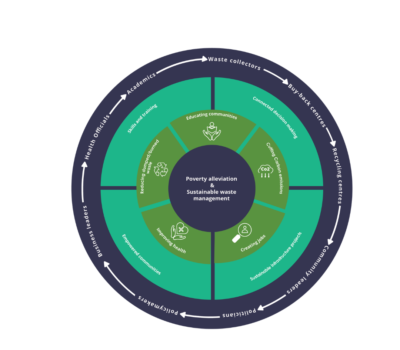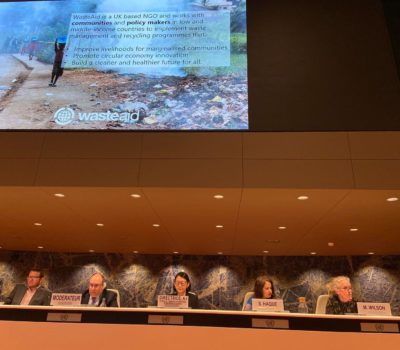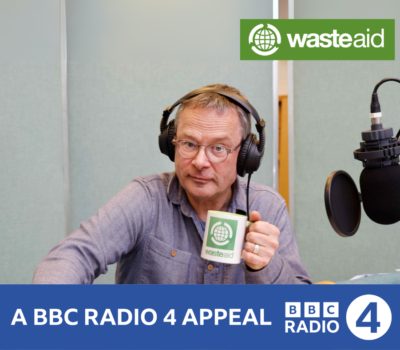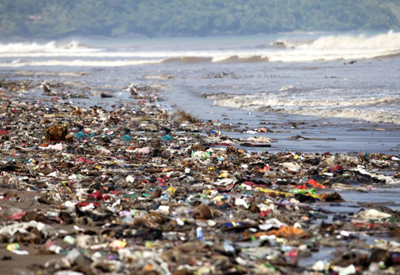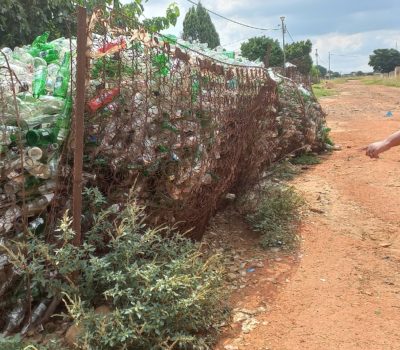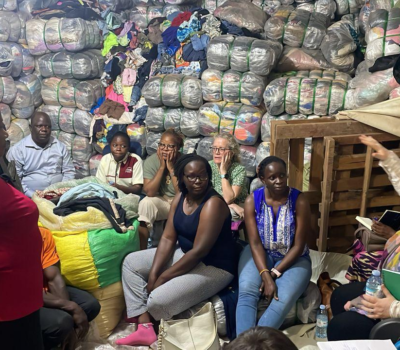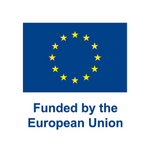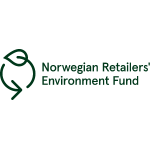WasteAid & COP26: Waste Management is a Climate Issue
News
Author: Admin
Published: 17 September 2021
Across the world, populations are growing and economies are evolving. But when we buy more, we also generate more waste, more pollution and more climate change emissions. Most countries are struggling to keep up. In fact, 1 in 3 people globally do not have access to a waste management service – leading to them burning it in their backyards or dumping it across their neighbourhoods.
The climate science? Open burning of waste in lower- to middle-income countries contributes up to 10% of global climate change emissions. That’s double the negative impact than found in the aviation industry. Yet, it has a simple solution that has been tested and trusted for decades.
Despite being a relatively quick win for the planet and people, however, waste management is still missed from the agenda at important climate conferences – including COP26.
Below, we break down exactly why waste is a climate issue and what needs to change for waste management to be taken seriously as a climate threat. We also look at why COP26 is so important and what WasteAid will be advocating for during the upcoming climate conference and beyond.
Why is waste a climate issue?
To understand how and why waste management is a climate issue, it can be helpful to start with the lens of what has already happened over the last couple of decades in the UK.
Today, the most potent greenhouse gas emissions from waste management in the UK are largely down to methane from landfill sites, waste incineration and transport.
Methane is a harmful gas that is emitted from landfills when biodegradable waste (anything that can be returned to the soil like food or paper) is buried and compressed. It is 24 times more potent in global warming terms than carbon dioxide (CO2). This shocking statistic is the reason the European Landfill Directive came into action in 2000, which mandated all member states to reduce the volume of their biodegradable municipal waste going to landfill.
As a result of the legislative act, local councils introduced kerbside recycling across the country while also increasing waste incineration for energy recovery – which is now under the spotlight as the UK’s most carbon-intensive way of generating energy.
But simple waste collection services are still not available in many other parts of the world.
For lower- to middle-income countries such as Nigeria, the majority of greenhouse gas emissions from waste are the result of open burning in backyards or dumpsites. The open burning of waste is a widespread practice in places with incomplete waste management systems. In fact, the activity contributes up to 10% of global carbon emissions – making poorly managed waste everyone’s issue.
As an example, let’s compare the two countries in terms of carbon emissions:
The United Kingdom generates around 500 metric tonnes of CO2 emissions each year. That’s roughly the same for Nigeria too. In the United Kingdom, however, waste is responsible for 4% of these emissions while this figure stands at 14% for Nigeria.
With no access to a waste management service, 1 in 3 people worldwide have no choice but to dump or burn their waste. Open waste burning is a significant emitter of black carbon, CO2 and carbon monoxide (CO) as well as other harmful gases like dioxins and furans.
These greenhouse gases (black carbon, CO2 and CO) lead to climate change.
Black carbon, dioxins and furans also have significant health impacts on people and animals (cancer is one example). In fact, nine million people die from diseases linked to waste and pollution every year. Pollution from open burning is particularly harmful to children, negatively impacting their health and physical and mental development.
Alongside reducing emissions, waste management plays an important role in building climate resilience.
Countries with inadequate solid waste management are often also the most vulnerable to climate shocks. Forest fires, flash floods and the spread of disease are on the rise in these regions. So, how exactly can waste management help to reduce these human-related environmental challenges?
To start with, forest fires can be reduced by eliminating the open burning of waste. Flash floods can be mitigated by the clearing of drains and waterways. Diseases can be avoided by keeping towns and cities clean, reducing mosquito breeding grounds and informal dumpsites that attract vermin, as well as reducing pollutants in air, groundwater, and the food chain.
Investment in sustainable and inclusive waste management systems means an investment in resilience to climate shocks and disasters for the most marginalised communities of today.
But for the international waste management community, securing financial investment isn’t all that easy. It brings another problematic question to light – how do you measure the impact from avoided open burning or poorly managed waste in general? While there are patterns, every pile of waste – and every community affected – is different to the next.
With no internationally agreed standard for estimating the climate emissions from open burning, waste management has been left off the agenda at COP26 once again. That’s despite knowing the activity contributes significant climate and health impacts, and has a relatively simple and affordable solution that is already available.
A global standard must be agreed for waste to be properly included in each country’s Nationally Determined Contributions (NDCs) and for waste management to attract sufficient climate finance.
How WasteAid is making an impact through its projects
Most of WasteAid’s activities contribute towards the reduction of climate emissions from poorly managed waste. Whether that’s increasing recycling in Cameroon, reducing food waste in The Gambia or supporting circular economy entrepreneurs in India, South Africa and Vietnam with seed funding and business mentoring.
As open burning is a commonplace approach to waste disposal in lower- to middle-income countries, any activity that diverts waste from disposal can avoid climate change emissions by reducing:
- Demand for raw materials (as extracting raw materials is carbon-intensive)
- Disposal route of open burning (which emits significant greenhouse gases)
- Biodegradable waste disposed of at dumpsites (where it has the potential to generate methane and/or be burned)
Programmes managed by WasteAid also build climate resilience by:
- Reducing waste that is blocking drains (which otherwise contribute towards flash floods and associated water-borne and mosquito-borne diseases)
- Regenerating natural systems (by returning waste back to its natural state and improving soil nutrient value and water retention)
Why is COP26 significant?
The upcoming climate conference, COP26, is the 26th United Nations Climate Change Conference. This year, it will be hosted in Glasgow, Scotland, under the presidency of the UK government 1st-12th November. But what makes this particular event so important?
COP26 is the first time that national governments across the world are expected to commit to “enhanced ambition” since COP21. That means reviewing and updating each of their Nationally Determined Contributions (NDCs) to reduce greenhouse gas emissions.
Commitments to reporting on NDCs were outlined during COP21 in 2015 as a result of the Paris Agreement. This agreement stipulates all parties involved must review their Nationally Determined Contributions in line with global emissions reduction targets and take on new commitments every five years.
COP26 was due to be held in 2020 but was postponed due to the COVID-19 pandemic.
What WasteAid and partners are advocating for at COP26 and beyond
COP26 presents a big opportunity for inadequate waste management to be taken seriously. Not only are the climate change emissions from open burning of waste backed by science, but the solutions are already available and easily replicable.
Together with our partners, here’s what WasteAid is advocating for at COP26 and beyond:
Short-term goals
First on the agenda? Poor waste management in lower- to middle-income countries to be recognised by global decision makers as a significant greenhouse gas emitter and barrier to climate resilience. Sustainable and inclusive waste management is a relatively quick win for the planet and people. But if the right people don’t know about it – or are unwilling to do something about it – then little is likely to change.
Without access to better infrastructure, the most marginalised communities in the world will struggle to gain control of their waste, impacting their health and livelihoods. Another of WasteAid’s goals is for lower- to middle-income governments to recognise that waste management is a cost-effective and achievable way to reduce climate change emissions. Waste tends to fall down the priority list in these countries as other needs, such as clean water and healthcare are rightly prioritised. Waste management, however, can help meet many of the Sustainable Development Goals at once while reducing climate emissions and building climate resilience.
One big challenge for the global waste community is the lack of a standardised method for measuring the emissions of poorly managed waste, making it difficult to attract climate finance for the issue. A key goal for WasteAid and partners is therefore getting global decision makers to agree to an internationally agreed standard for estimating the climate impact of poorly managed waste in lower- to middle-income countries.
Sustainable waste management doesn’t stop at measurement though. To prevent climate change and work towards sustainability, the old ‘business-as-usual’ trajectory must change. That’s why WasteAid is campaigning for a circular economy approach and its positive contribution to preventing climate change to be recognised by policy makers and supported through funding decisions.
Mid-term goals
Waste management needs a seat at the table, especially when it comes to important climate conferences like COP26. A further shared goal is for lower- to middle-income countries to include solid waste management in their NDCs. By incorporating the issue into their national climate targets, countries will become accountable for making improvements to waste management infrastructure while raising the quality of life for their citizens.
But these countries can’t do this alone. Despite generating the least emissions per person and having the least agency to change current practices, it is the most marginalised communities who are the most affected. That is why WasteAid is advocating for climate finance to be directed towards waste management in lower- to middle-income countries. Waste management can reduce emissions significantly and help protect the poorest from climate shocks, like forest fires or flash floods.
Long-term goals
For WasteAid and partners, long-term is that a funding and policy focus leads to improved sustainable waste management in lower- to middle-income countries. This in turn will lead to improved sustainable waste management, reducing climate emissions and building climate resilience. By achieving these goals, climate change emissions can be significantly reduced and the lives of millions of people within the most marginalised areas of the world greatly improved.
Together for our planet
Waste is an inevitable by-product of human life. Whether in large or small amounts, almost every human activity has some sort of waste-related side effect. But it is the way in which we manage waste that is the most important factor when it comes to climate change.
Are you attending COP26? Come along to the WasteAid & Bright Blue panel discussion event ‘The Burning Issue? Waste, Climate, Health and Development’ on 11th November at 10:00 (UTC) to get to grips with the challenge on an even deeper level. Watch this space for more information coming soon.
Think waste needs sorting? Follow WasteAid on Twitter and LinkedIn as we release new content in the run up to COP26, educating and inspiring the world to take action.
Written by Nat Libby

